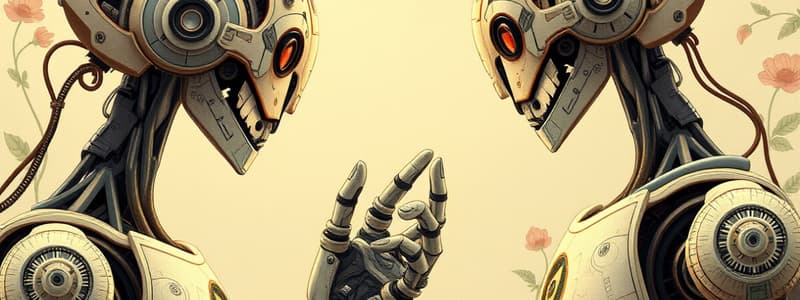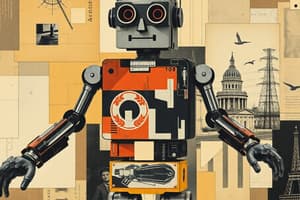Podcast
Questions and Answers
What advantage do robots have over humans in hazardous environments?
What advantage do robots have over humans in hazardous environments?
- Robots can perform creativity tasks better than humans
- Robots require frequent breaks
- Robots can process emotions effectively
- Robots do not need life support or comfort (correct)
Which of the following is a limitation of robots?
Which of the following is a limitation of robots?
- They can understand complex emotions (correct)
- They can simultaneously process multiple stimuli
- They have precise motion capabilities
- They can effectively replace human workers
What is a characteristic of a fixed-sequence robot?
What is a characteristic of a fixed-sequence robot?
- It performs stages of a task according to a predetermined method (correct)
- It records human actions for later playback
- It can adapt its tasks based on changing environments
- It can work with multiple operators simultaneously
What is a primary reason robots can work continuously without fatigue?
What is a primary reason robots can work continuously without fatigue?
What economic consequence is associated with the increase of robots in the workforce?
What economic consequence is associated with the increase of robots in the workforce?
In terms of sensory processing, how do robots compare to humans?
In terms of sensory processing, how do robots compare to humans?
Which factor contributes to the high cost of implementing robots?
Which factor contributes to the high cost of implementing robots?
How do playback robots operate?
How do playback robots operate?
What does ISO 8373 define as a robot?
What does ISO 8373 define as a robot?
Which of the following statements about Karel Čapek and his contribution to robotics is true?
Which of the following statements about Karel Čapek and his contribution to robotics is true?
What is the purpose of Isaac Asimov's 'Three Laws of Robotics'?
What is the purpose of Isaac Asimov's 'Three Laws of Robotics'?
Which statement accurately reflects a common advantage of using robots in various industries?
Which statement accurately reflects a common advantage of using robots in various industries?
Which law is considered the 'Zeroth Law' in Asimov's framework?
Which law is considered the 'Zeroth Law' in Asimov's framework?
What does Merriam-Webster's definition of a robot emphasize?
What does Merriam-Webster's definition of a robot emphasize?
What is the main function of effectors in a robot?
What is the main function of effectors in a robot?
Why are robots essential in military applications?
Why are robots essential in military applications?
How can robotics be beneficial for aiding disabled individuals?
How can robotics be beneficial for aiding disabled individuals?
Which component of a robot is responsible for computations that enhance the robot's success?
Which component of a robot is responsible for computations that enhance the robot's success?
What does the term 'perception' refer to in robotics?
What does the term 'perception' refer to in robotics?
Which of the following best describes an intelligent robot?
Which of the following best describes an intelligent robot?
What role do actuators play within a robotic system?
What role do actuators play within a robotic system?
What is an end effector in the context of robotics?
What is an end effector in the context of robotics?
How does communication in robots most commonly occur?
How does communication in robots most commonly occur?
What are the major components that form a robotic system as mentioned?
What are the major components that form a robotic system as mentioned?
What is the role of actuators in a robot?
What is the role of actuators in a robot?
Which type of software is responsible for calculating the necessary motions of each joint in a robot?
Which type of software is responsible for calculating the necessary motions of each joint in a robot?
What essential function do sensors perform in a robot?
What essential function do sensors perform in a robot?
How does the controller function in a robotic system?
How does the controller function in a robotic system?
What is the relationship between the processor and the controller in a robot?
What is the relationship between the processor and the controller in a robot?
Which of the following is NOT a type of actuator mentioned for robots?
Which of the following is NOT a type of actuator mentioned for robots?
Why does a robot need to know the position of each link?
Why does a robot need to know the position of each link?
What is the primary role of the operating system in a robot?
What is the primary role of the operating system in a robot?
Flashcards are hidden until you start studying
Study Notes
Robotics Overview
- Robotics combines art and technology, focusing on the design, application, and use of robots across various industries.
- Applications include manufacturing, space exploration, research, assistance for disabled individuals, military use, and entertainment.
- Defined by ISO 8373 as an "automatically controlled, reprogrammable, multipurpose manipulator" with at least three axes.
- The Robot Institute of America highlights robots as multifunctional manipulators for moving materials and tools through programmed motions.
Historical Context
- Karel Čapek coined the term "robot" in his play Rossum’s Universal Robots, addressing themes of work automation by man-made beings.
- "Robotnik" means peasant, and "robota" translates to drudgery or servitude in Czech.
- Isaac Asimov introduced the "Three Laws of Robotics":
- Zeroth Law: Prevent harm to humanity.
- First Law: Prevent harm to individual humans unless in conflict with a higher law.
- Second Law: Obey humans, unless in conflict with higher laws.
- Third Law: Protect its own existence, unless in conflict with higher laws.
Advantages and Disadvantages of Robots
- Advantages:
- Increased productivity, efficiency, and quality in various tasks.
- Ability to work in hazardous environments without human limitations.
- Continuous operation without fatigue or need for rest.
- High precision and capability to handle multiple tasks simultaneously.
- Disadvantages:
- Economic impact on the workforce, leading to job displacement and retraining needs.
- Limited emergency response capabilities.
- Safety measures required to protect human workers.
- Lack of cognitive abilities compared to humans.
Robot Classification
- Fixed-sequence robots: Perform tasks in a predetermined order, hard to modify.
- Playback robots: Learn tasks from human operators and repeat recorded motions.
- Numerical-control robots: Movements are programmed directly, rather than learned by demonstration.
- Intelligent robots: Adapt to changing environments and complete tasks successfully.
Robotic Components
- Effectors: Movable parts like arms and legs that enable action in the environment.
- Perception: Sensors act as the robot's senses, collecting data about the surroundings.
- Control: The computing system that directs robot functions and actions.
- Communication: Mechanisms that allow robots to interact with humans and other systems.
- Power: Supplies energy that enables all robotic functions.
Robot System Elements
- Manipulator or rover: Main body structure composed of links and joints.
- End effector: The robot's "hand" that interacts with external objects, equipped with tools like welding torches.
- Actuators: Move the robot’s components under signals from the controller.
- Sensors: Gather information for assessing the robot's position and surrounding environment.
- Controller: Manages motions and system feedback, analogous to a brain's functionality.
- Processor: Executes calculations for movements and oversees system coordination.
- Software: Includes the operating system, robotic software for calculating motion, and application-specific routines for various tasks.
Studying That Suits You
Use AI to generate personalized quizzes and flashcards to suit your learning preferences.




